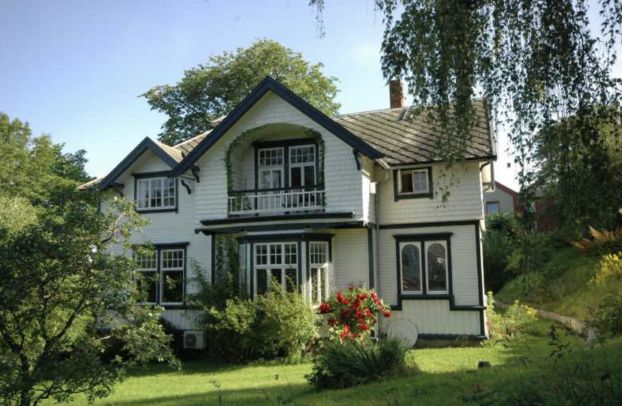
Da huset sto nytt bodde det mellom 6 og 10 familier i huset
I 1966 skrev 19-åringen Åge Levva livet, på rommet sitt i fjerde etasje i Bakklandet 17. Tip: Find Levva livet on Spotify.
SpareBank 1 Boligkreditt AS (‘Boligkreditt’, ‘SpaBol’, or ‘The Company’) is a specialized covered bond issuer. It is regulated as a credit institution and licensed by the Norwegian Financial Supervisory Authority (Finanstilsynet) and is operating according to the legislation for covered bonds in Norway1.
The purpose of the Company is solely to provide funding for its owner banks by buying qualifying residential mortgage loans from them with a loan-to-value (“LTV”) of up to 75 per cent and financing these through the issuance of covered bonds 2. The Company is an integrated part of the operations of its owner banks. When these banks transfer a portion of their residential mortgages to Boligkreditt for funding purposes, all customer relationship activities and aspects remain with the originating bank. The mortgages that may be transferred to the Company follow from a specific rule set.
The Company, which is based in Stavanger, Norway, is owned by banks throughout Norway and which are all members of the SpareBank 1 Alliance. The Company pays the net interest margin earned on mortgages to its owner banks, with deductions for its funding and operating costs. This margin is accounted for as commissions to owner banks, which are contractually committed to maintain the Company’s equity capitalization at or above regulatory requirements.
The Company’s issuances of covered bonds mainly take place under the EUR 35 billion Global Medium Term Covered Note Programme (GMTCN Programme). This Programme was updated on April 26, 2022 and is available on the Company’s home page: https://spabol.sparebank1.no.
Moody’s Ratings Service evaluate the credit quality of the issuances under the GMTCN Programme. The issued covered bonds are rated Aaa.
[1] The covered bond legislation in Norway is from July 2022 incorporates the Directive (EU) 2019/2162
[2] The limit for instalment mortgages is 75 per cent, while mortgages which have no scheduled repayment structure are limited to 60 per cent. There is a regulatory minimum amortization requirement of 2.5 per cent annually for new mortgages with a LTV at 60 per cent or above.
SpareBank 1 Boligkreditt’s cover pool consists of residential mortgages and liquid, highly rated assets as well as derivatives hedging liabilities in a foreign currency and/or at fixed rates. The chart below illustrates the balances as of December 31, 2022. The balances are based on a new nominal principle introduced from the 3rd quarter 2022 where bonds (covered bonds issued as well as bonds held within liquid assets) are presented at par. This means that derivatives hedging these instruments, tailored at the time of issuance to exactly transform a bond’s fixed annual coupon to a NOK 3-month floating rate basis over the whole tenor of a bond, are effectively incorporated within the nominal values of the bonds.
[3] The source is the cover pool asset liability test for overcollateralization as of December 31, 2022 (also included as a note to the financial statements).
The amount of liquid assets varies over time and the variation is solely a result of the Issuer’s liquidity risk management (and regulatory requirements), whereby upcoming redemptions are refinanced prior to the maturity of outstanding bonds (minimum 180 days) with bond proceeds invested as liquid assets. Liquid assets are covered bonds with a triple-A rating, SSA or government bonds with a triple-A rating, or short-term cash deposits and repos (please see the cover pool statistical reports on spabol.no for details on the composition of liquid assets).
Derivatives are used solely to hedge currency and interest rate risk. They are tailored to exactly match the cash flows related to the bonds they hedge, for the full duration of the bond. Swap counterparties are
subject to certain rating criteria and are in all cases banks other than the Company’s owner banks.
Counterparties post collateral to Boligkreditt for its swap exposures.
The table below provides an overview of the residential mortgages in the cover pool, as well as the over-collateralization.
| Q4 2022 | Q3 2022 | Q2 2022 | Q1 2022 | Q4 2021 | |
|---|---|---|---|---|---|
| Weighted Average Current LTV (%) | 49.2 % | 48.3 % | 48.3 % | 50.0 % | 51.0 % |
| Weighted Average Original LTV (%) | 60.1 % | 60.2 % | 60.2 % | 60.1 % | 59.9 % |
| Average Loan Balance (NOK) | 1,702,210 | 1,680,036 | 1,646,872 | 1,624,097 | 1,593,078 |
| Number of Mortgages in Pool | 148,328 | 145,739 | 144,086 | 141,872 | 139,495 |
| Pct. of non first-lien mortgages | 0.0 % | 0.0 % | 0.0 % | 0.0 % | 0.0 % |
| Overcollateralization | 5.3 % | 5.3 % | 5.4 % | 5.6 % | 5.7 % |
A total of NOK 37.22 billion was issued during all of 2022, a record. SpaBol also issued an inaugural CHF 210 million covered bond and EUR 3.5 bn during the year. Credit spreads on covered bonds have generally widened over 2022 in EUR and NOK, along with the broader market.
The residential mortgage lending volume which SpaBol finances grew by 13.5 per cent ove the year, which is strong growth. The volume of mortgages financed grew significantly above the underlying growth in mortgage lending among the SpareBank 1 banks, as the banks utilized covered bond funding more than from other sources during the year. The financed mortgage volume stands at NOK 253 billion at the end the year.
Norway has implemented the EU’s harmonization directive for covered bonds, as well as changes to Article 129 in CRR (Capital Requirement Regulation). These changes became effective by the deadline in early July 2022. SpaBol will issue European Covered Bonds (Premium) forthwith. Of note is an increase in the regulatory overcollateralization requirement for cover pools to 5 per cent from 2.5 per cent prior. The Issuer has a 5.3 per cent overcollateralization as of December 31, 2022. Substantial additional cover pool reserves – qualified mortgages – are however available on the balance sheets of SpaBol’s issuer banks.
The Norwegian authorities presented the Near Zero Emissions Buildings Standard (NZEB) in early 2023. This was a requirement in the Energy Performance Buildings Directive 2010/31/EU and is important because it is part of the green buildings definition under the EU Taxonomy, for buildings constructed after 2020. With this standard now available, Norwegian green bond issuers are probably going to amend their Green Bond Frameworks during 2023 to include the definition. SpaBol is now preparing this work.
The accounts have been prepared in accordance with the International Reporting Standards (IFRS) as adopted by the EU and published by the International Reporting Standards Board (IASB).
The Board views the accounts as presented to be a true representation of SpareBank 1 Boligkreditt’s operations and financial position as of the end of Q4 2022. Numbers in brackets refer to the corresponding period last year for comparison.
The total balance sheet as at December 31, 2022 amounted to 288 (258) billion kroner. The main reason behind this increase is growth in the financed volume of mortgages of NOK 253 billion vs. NOK 223 billion a year earlier.
The Company had in 2022 net interest income of NOK 1.644 (2.344) million, which includes both mortgage interest and interest income from liquid assets. The decrease, despite a higher volume of mortgages on the balance sheet, is mainly due to a reduced mortgage net lending margin. This happens because the 3-month NIBOR rate, which is the funding basis for covered bonds, has increased faster and by more than the variable mortgage rate over the year. Mortgage rate increases must by law be delayed by 6 weeks (8 weeks from 2023) before becoming effective after announcement. All of the Company’s mortgages are at a variable rate, and Boligkreditt has the right to set and change the variable rate on its mortgage loans. However, Boligkredtt will in practice always defer to the SpareBank 1 bank which originated the loan for this decision. Banks set and change their variable mortgage rates in competition with other banks and are often guided by changes in the central bank policy rate when doing so. Commission expense to SpareBank 1 banks, which are the payments of most of the net interest margin to the Issuer’s loan originating owner banks, show a corresponding decrease.
The cost of operations for 2022 was NOK 44.3 (38.9) million. The majority of operating costs are for expenses related to the Company’s bond issuances, IT operations as well as personnel related expense.
IFRS 9 loan loss provisions increased by NOK 16.5 million (decreased by 15) to NOK 31.5 million. No actual loan losses have occurred. Credit spread widening on the Company’s bonds held in its liquidity portfolio produced
unrealized valuation losses during the period, mainly during the first half of the year. These, along with
increased loan loss provisions and temporary mark to market losses on the floating NOK leg of swaps hedging fixed rate issued covered bonds in EUR and NOK, is the main reason for a reduced operating result of NOK 45.8 million (131.5) before tax. This operating result includes no deduction for scheduled interest payments to Additional Tier 1 bondholders, which are classified as distribution to equity capital.
The Company’s own liquid assets were approximately NOK 30.3 (23.9) billion as of the end of the fourth quarter 2022. The volume of Boligkreditt’s liquid assets is rules driven. Liquid assets are cash and highly rated, highly liquid bonds being held as a function of refinancing the Company’s upcoming bond maturities at least six months ahead of expected maturities. The volume of liquid assets is, at a minimum, managed to meet the 180-day minimum liquidity rule in the EU covered bond harmonization directive.
SpareBank 1 Boligkreditt, as a licensed and regulated covered bond issuer, is subject to strict rules regarding its exposure to credit, market, and liquidity risks. This fact, and the aim of the maintenance of the Moody’s Aaa rating, means that the Company is subject to low levels of risk and places strong emphasis on risk control.
Credit Risk is defined as the risk that losses can occur as a consequence of that customers and others not having the ability or willingness to meet their obligations to SpareBank 1 Boligkreditt. Because the Company buys residential mortgages within 75% of the value of the objects on which the mortgages are secured, the Board of Directors concludes that the credit risk is lower than for Norwegian banks in general.
Market risk is defined as the risk of losses due to changes in market rates, ie. Interest rates, exchange rates and the prices of financial instruments. SpareBank 1 Boligkreditt issues a materially larger share of covered bonds in currencies other than its operational currency NOK. However, all borrowing and investments in a foreign currency, as well as such with a fixed rate, have been hedged by financial currency- and/or interest rate swap agreements. Some natural hedging may occur with EUR assets matching EUR liabilities. The collective cash flow therefore matches borrowing in Norwegian kroner with floating rate conditions (NIBOR 3 months). The Company receives cash collateral from its counterparties in derivative agreements.
The bonds held in the Company’s liquidity portfolio are mainly Nordic covered bonds and German supra sovereign and agencies (agencies guaranteed by the German government) with a triple-A rating from Fitch, Moody’s or S&P. These bonds are held on a 3-month basis either as FRNs or as swapped fixed rate bonds. Deposits are placed in banks with a minimum rating of A/A2. Cash is also placed in reverse repos with approved counterparty banks, with AAA rated securities as collateral.
The Company had as of December 31, 2022 only moderate interest rate risk, and small amounts of currency risk.
Liquidity risk is defined as the risk that the Company is not able to meet its obligations at maturity or to finance the purchase of loans at normal terms and conditions. Liquidity risk is managed based upon a liquidity strategy approved by the Board of Directors. According to the strategy, SpareBank 1 Boligkreditt AS shall maintain a liquidity reserve with a minimum size equal to or more than all debt maturities within the next 6 months. The Board of Directors views SpareBank 1 Boligkreditt AS’s liquidity situation as good.
Operational risk is defined as risk of loss due to error or neglect in transaction execution, weakness in the internal control, or information technology systems breakdowns or malfunction. Reputational, legal, ethical and competency risks are also elements of operational risk. The risk is assessed by the Board of Directors to be moderate.
The Company spends much time identifying, measuring, managing, and following up on central areas of risk in such a way that this contributes to meeting its strategic goals. The notes 24 through 28 in the 2021 annual accounts provide further information.
SpareBank 1 Boligkreditt had seven direct employees as of 31.12.2022, of which six are male and one female. The Company is serviced by a number of other functions in the SpareBank 1 Alliance. The Company has a Transfer and Servicing Agreement with each shareholder bank which is handling the customer contact and servicing the mortgage portfolio on behalf of the Company. In addition, the Company purchases a significant amount of its support functions from SpareBank 1 SMN, e.g. accounting, HR and finance related back-office functions. Boligkreditt is served by a central SpareBank 1 Alliance unit for IT specific needs and further operational activities.
The Company has moved into new offices in downtown Stavanger, Norway in early 2020. These are energy efficient with a BREEAM-NOR certification of very good. The EPC label is B, while energy use is 85 kWh/m2 and running Co2 emissions are 12.9 kg Co2/m2. The company provides no car parking spaces. There has been no material per cent employee absence recorded in 2022 due to sickness. No workplace accidents which might have resulted in property and/or damage to any persons have occurred or been reported during the year.
The Board consists of seven persons of which four are male and two are female. SpareBank 1 Boligkreditt AS strives to achieve an even distribution between the genders in recruiting for the staff and the Board.
SpareBank 1 Naeringskreditt AS, which is smaller and finances commercial property lending, but also is a covered bond issuer, has identical staffing to Boligkreditt. Of the seven full time employees employed at year-end in both SpareBank 1 Boligkreditt and Naeringskreditt AS, 1.4 full time equivalents have been allocated to SpareBank 1 Naeringskreditt AS. The Boards of the two companies also have an identical composition at year-end 2022.
SpareBank 1 Boligkreditt’s principles for corporate governance are based on the Norwegian accounting law and regulations and the Norwegian practice for corporate governance. Through its financial accounting, Boligkreditt seeks to deliver relevant and timely information for its owner banks, regulatory authorities and participants in the capital markets. The Board evaluates and approves Management’s proposed annual and quarterly financial accounts.
Boligkreditt maintains an administration which is suitable for the purposes, activities and extent of the business. The Management routinely evaluates risk factors to the business along with an evaluation of their probability and consequence. The Company aims to ensure that procedures and policies are in place to address these risks in an appropriate manner. Material breaches in the policy and procedures, and all breaches of financial risk limits or regulatory requirements, are reported to the Board of Directors.
The Company has insurance in place for professional responsibility for the Board of Directors and its employees, as well as insurance coverage regarding cyber related claims (hacking, ransom etc.) and for losses due to criminal acts towards the Company. All insurance policies are held jointly within the SpareBank 1 Alliance.
The Company has ethical rules that prohibits corruption (engaging in bribes is a criminal offence in Norway). The rules provide guidelines for how to avoid conflicts of interest and unethical conduct towards customers, counterparties, and the society as a whole.
The Company publishes its Corporate Governance policies in a document available on the Company’s website www.spabol.no.
The Company’s shareholders are solely banks in the SpareBank 1 Alliance (or banks owned by these banks) which have sold and transferred mortgages to the Company. The shareholder’s agreement includes a clause that the Shareholders must maintain a minimum equity capitalization of Boligkreditt consistent with minimum regulatory requirements. In case of a rights issue, the shareholders are obliged to subscribe shares according to its current share of the shareholdings. The Company is not party to agreements which come into force, are amended, or are terminated as a result of a takeover bid.
SpareBank 1 Boligkreditt is a specialized issuer of covered bonds, set up according to Norwegian law requirements for issuers of covered bonds. Despite the relatively large size of its balance sheet, Boligkreditt has strict limitations on its activities and has only seven full time employees. The nature of the business consists solely of buying residential mortgage loans from its shareholder banks in the SpareBank 1 Alliance, and to finance these by issuing covered bonds. Every other activity, such as entering into derivatives agreements, receiving collateral related to those and maintaining and investing own liquid assets, follow from this single business purpose.
The banks in the SpareBank 1 Alliance operate as universal banks in the Norwegian market with an array of activities, including lending to businesses and households. These banks in total have around 6,000 employees and are together Norway’s second largest financial group by assets and lending. Boligkreditt’s parent banks set lending policies, service and handle all mortgage customer activity (including the customers whose mortgage loans have qualified for and been sold to the Company). Because of this, the ESG policy of the Company is aligned with its owner banks within the relevant areas for the Company. The SpareBank 1 banks present their ESG reports and further material on their websites and/or annual reports. The ESG reports, including GHG emissions reporting, of the main Boligkreditt shareholder banks can be found here:
SpareBank 1 Boligkreditt is effectively an extension of its parents banks (a funding arm) and their ESG policies apply to the extent relevant to the Company. The Company adopts the same set of ESG values and goals as the owner banks (see in particular the document “ESG policy in SpareBank 1 Boligkreditt” under the Green Bonds section of the pabol.no website).
Several of the owner banks offer ‘environmental mortgages’, where a discounted rate is offered to consumers planning to build energy efficient houses or for substantial energy efficiency upgrades. These loans will also to a large extent qualify for green bond issuance when transferred to SpareBank 1 Boligkreditt.
In the area of mortgage finance the originating banks are obligated by Norwegian mortgage market regulations to analyse the financial sustainability of mortgage debt that borrowers are seeking. The banks are also obligated to not approve and provide advice to customers who are seeking debt levels which may be or become unsustainable. This is enshrined in the Norwegian government’s residential mortgage lending legal rule book, and applies to all of the Company’s financed mortgages.
Transparency Act
A Norwegian Act with regard to enterprises’ transparency and work on fundamental human rights and decent working conditions (Transparency Act "Act") came into effect on July 1, 2022. Boligkreditt is a Company, due to its size, which falls within the remit of the Act.
The Act requires that due diligence shall be carried out regularly and in proportion to the size of the enterprise, the nature of the enterprise, the context of its operations, and the severity and probability of adverse impacts on fundamental human rights and decent working conditions. A key aspect to the Act is for an enterprise to assess and report any risks that might stem from its chain of suppliers, with regards to the purpose of the Act, which is to enhance and protect human rights and decent working conditions.
Because SpareBank 1 Boligkreditt solely is a specialist issuer of covered bonds, its activities are very limited. The SpareBank 1 owner banks, which transfer residential mortgages to the Company as a part of their funding, continue to service mortgages and maintain all aspects of the customer relationships for the loans that are transferred. This is regulated by a Transfer and Servicing Agreement which each owner bank has signed with its subsidiary. One large owner bank, SpareBank 1 SMN, functions in a special service capacity for Boligkreditt; it provides payments and settlements, a securities pricing function as well as accounting and reporting services and human resources. Other suppliers to Boligkreditt are legal firms in Norway and the UK, as well as internationally established auditing practices.
The Company purchases services and goods from SpareBank 1 Utvikling, a SpareBank 1 Alliance internal services company. SpareBank 1 Utvikling has, since 2019, on behalf of the SpareBank 1 Alliance, analysed, and, if needed, followed up its suppliers, to confirm or improve compliance with its sustainable and responsible business guidelines. The report of this work will be included in a report about the Transparency Act as it is understood to pertain to SpareBank 1 Boligkreditt. The report will be published on https://spabol.sparebank1.no/about, under Constitutional Documents and Corporate Governance.
There is an expectation of lower GDP growth in 2023, although slightly revised upwards in March 2023 from December 2022. Private consumption is seen as vulnerable after interest rate increases, though positive growth is projected for the year 2023 and this forecast is again higher in March 2023 compared to December 2022. Business investment, after energy price and interest rate increases, is lower, but also in positive growth territory for 2023, with the main driving being the oil and gas sector. Household real income growth was negative in 2022 and is expected zero in 2023, although the uncertainty around this is high. Unemployment is expected a little higher in 2023 on average compared to 2022.
Norway’s current account surplus to GDP as an energy exporter is particularly high, at over 30 per cent in 2022 and a projected 17 per cent in 2023. Oil and gas investments are expected to increase significantly from 2023 onwards, due to the increased demand from Europe. However, uncertainties remain with regards to future energy prices.
Housing investment (construction) has over some years delivered negative GDP contributions and is expected negative also in 2023. This is tied to increased mortgage interest rates, which are expected around 5 per cent for variable mortgage loans later in 2023. The housing market price index appreciated by 1.5 per cent overall in 2022, though the 2nd half saw a correction of 6.7 per cent (July-December). Several analysts are expecting a low single digit contraction in 2023, but within a broader range of possible outcomes. In response to increased market rates, mortgage lending regulations where relaxed somewhat from January 2023. Most importantly the interest stress test currently requires banks to add 3 per centage points to the offered rate to stress the
mortgage loan applicant’s repayment ability (reduced from 5 per cent). This would enable borrowing which would have been rejected at the previous higher stress level and supports the market.
Summarized for a few macroeconomic indicators, the recent data and forecast for the next period are as follows:
| Recent data and forecast (per cent) | 2020 | 2021 | 2022 | 2023 | 2024 |
|---|---|---|---|---|---|
| Mainland GDP growth | -2.8 | 4.2 | 3.8 | 1.3 | 1.6 |
| Private consumption growth | -6.2 | 4.4 | 6.8 | 1.2 | 1.5 |
| Investments growth | -4.1 | -0.8 | 4.4 | 1.8 | 1.9 |
| Unemployment rate | 4.7 | 4.4 | 3.2 | 3.6 | 3.8 |
| CPI growth | 1.3 | 3.5 | 5.8 | 5.0 | 2.3 |
| Annual wage growth | 3.1 | 3.5 | 4.4 | 5.0 | 4.5 |
| Current account surplus to GDP | 1.1 | 13.6 | 30.4 | 16.6 | 16.8 |
[4] Macroeconomic projections have been sourced from Statistics Norway as of March 19, 2023.
The Company has a portfolio of residential mortgage loans with an average loan to value (LTV) around 50 per cent, and no loans are in default. The maximum allowable level for a mortgage in a cover pool is 75 per cent LTV, with amounts above that level not being eligible as a cover pool asset.
SpareBank 1 Boligkreditt’s residential mortgage portfolio is well diversified, albeit weighted towards the eastern, central, and northern regions in Norway. Mortgage loans in the cover pool are very granular (average size of 1.7 million kroner). The banks in the SpareBank 1 Alliance are required to keep reserves of eligible (i.e. cover pool pre-qualified) mortgages in order to provide replacement assets should this become necessary (i.e. if residential price declines increase LTVs above the eligibility limit for mortgages in the pool). Such reserves in the banks are tested regularly to verify that a 30 per cent decline in market real estate prices leaves each member bank with sufficient qualifying reserves for replenishing the cover pool.
The Board of Directors views Boligkreditt as well capitalized with a capital coverage ratio of 22.2 per cent against a total requirement, including all buffers, of 17.0 per cent (Pillar 1) plus 0.9 per cent (Pillar 2). The countercyclical buffer capital requirement increased to 2.0 per cent as of December 31, 2022 and will further increase to 2.5 per cent as of March 31, 2022.
Total equity Tier 1 capital is 19.9 per cent against a requirement, including buffers, of 15.9 per cent. Common equity capital was 18.4 per cent against a requirement, including all buffers, of 14.4 per cent. It is the Company’s policy to maintain capital ratios slightly above the regulatory requirements (a management buffer). When required, additional common equity is paid in by the owner banks in the regular course of business, usually in connection with increases in transferred mortgage volume. Additional Tier 1 and Tier 2 capital is raised in the Norwegian domestic capital market.
The Board of Directors views prospects for the Company to continue to be good and stable, despite the changed macroeconomic forecasts towards lower growth ahead. This is based on several elements: a strict qualifying process for loans to become part of the cover pool (bank lending practices, mortgage lending regulations and cover pool qualification requirements), a high degree of diversification and granularity of the mortgages in the pool, as well as the robustness of the Norwegian economy, including the strong financial resources available to the Norwegian state. The Board also bases this conclusion on the low average LTV of the mortgage portfolio, no defaults or loans in arrears, and a strong history and institutional framework in Norway for mortgage loan performance.
* * *
The Board of Directors affirms its conviction that the financial accounts present a correct and complete picture of the Company’s operations and financial position at the end of 2022. The financial accounts including notes are produced under the assumption of a going concern.
Hemsedal, March 22, 2023
The Board of Directors of SpareBank 1 Boligkreditt AS

/s/ Bengt Olsen
Chair

/s/ Geir-Egil Bolstad

/s/ Trond Søraas

/s/ Steinar Enge

/s/ Heidi C. Aas Larsen

/s/ Merete N Kristiansen

/s/ Knut Oscar Fleten
The Board and the chief executive officer have today reviewed and approved the financial accounts as of December 31, 2022 for SpareBank 1 Boligkreditt AS. The accounts have been prepared in accordance with the International Financial Reporting Standards (IFRS), as adopted by the EU.
To the best knowledge of the Board and the chief executive officer the accounts have been prepared in accordance with applicable accounting standards and give a true and fair view of the assets, liabilities, financial position and profit or loss of the Company taken as a whole as of December 31, 2022.
The Board of Directors and the chief executive officer declare to the best of their knowledge that the annual report gives a true and fair view of the development and performance of the business of the Company, as well as a description of the principal risks and uncertainties facing the Company.
/s/ Bengt Olsen
Chair
/s/ Geir-Egil Bolstad
/s/ Trond Søraas
/s/ Heidi C. Aas Larsen
/s/ Merete N Kristiansen
/s/ Knut Oscar Fleten
/s/ Steinar Enge
/s/ Arve Austestad
Managing Director

SpareBank 1 Boligkreditt is a labelled covered bond issuer. Details of the label and information on SpareBank 1 outstanding covered bonds are available on the European Covered Bond Council (ECBC) covered bond label webpage:
www.coveredbondlabel.com